The updated saga of New Zealand's first professional magician.
BY: BERNARD REID GMM
edited by: Andy Wonder - Brisbane Magician
May 29, 2020 - 5 minute read
About 30 years ago I became interested in the history of show business in New Zealand. This fascinationor obsession has never abated and I have come across some amazing stories of performers who paved the way for our very existence. In the middle of the 19th century there were entertainers touring the country when there was no infrastructure whatsoever. No roads, no railway, no automobiles, every mode of transportation was on horseback or drawn by horses.
One performer that captured my attention was a young lady born on February 5th 1855. Her birth name was Jane Whiteside although this changed many times during her short career. I was first introduced to Jane by James Reilly (1929—2019). James was the editor of the New Zealand magicians’ magazine Magicana in which he wrote a brief column about Jane Whiteside. He later expanded this into a pamphlet Darling Jennie which was produced with a very limited print run. All of Jim’s research preceded the advent of the Internet, so was done by accessing microfiche and microfilm in libraries’ archives a very long and laborious process.
Not long after the introduction of the Internet, the Alex Turnbull Library/National Library introduced Paperspast which is an amazing website that gives access to literally millions of pages of New Zealand newspapers from the very earliest in 1839. This website, plus other leads, meant I was able to add a lot to the original work that James had done so herewith the updated saga of New Zealand’s first professional magician, surprisingly a female.
Born on 5th February 1855 in Clare, County Down, Northern Ireland, Jane was the first child of John and Jane Whiteside. John Whiteside was a weaver. The industrial revolution introduced machine spinning to the area in 1850 making the skilled tradesmen redundant, so in February 1855 John joined the 65th Regiment, which at that time was recruiting men from all over the British Isles, for service in Australia and New Zealand. John Whiteside and family sailed from London on the Lancashire Witch on 17th April 1856 and more than three months later landed in Wellington on 21st July. John and his family were relocated a number of times, finally settling in Otahuhu which at that time was a satellite village of Auckland.
In Jane's published obituary it is mentioned that she had been a professional acrobat, tight-wire walker and trapeze artist. Eventually she was tracked down working under the name of Madamoiselle Blanche and Blanche Fane with two different touring troupes at different times covering Auckland, Waikato, Thames and Northland. Blanche, of course, meaning White. It is very intriguing that there was someone teaching the sophisticated and demanding techniques of tight-rope walking and trapeze work in the 1860s in Auckland with a total population of just on 11,000. Jane must have started learning when she was very young as she was touring professionally in 1872 when she was just 17 years of age. A single brief mention is made of the fact that Jane had to give up tight-rope walking and trapeze as the result of an accident. Frustratingly, there is no explanation as to what this accident consisted of or how it happened. If it was an accident in performance one would think it would be covered by the press yet incessant searches turned up no mention anywhere.
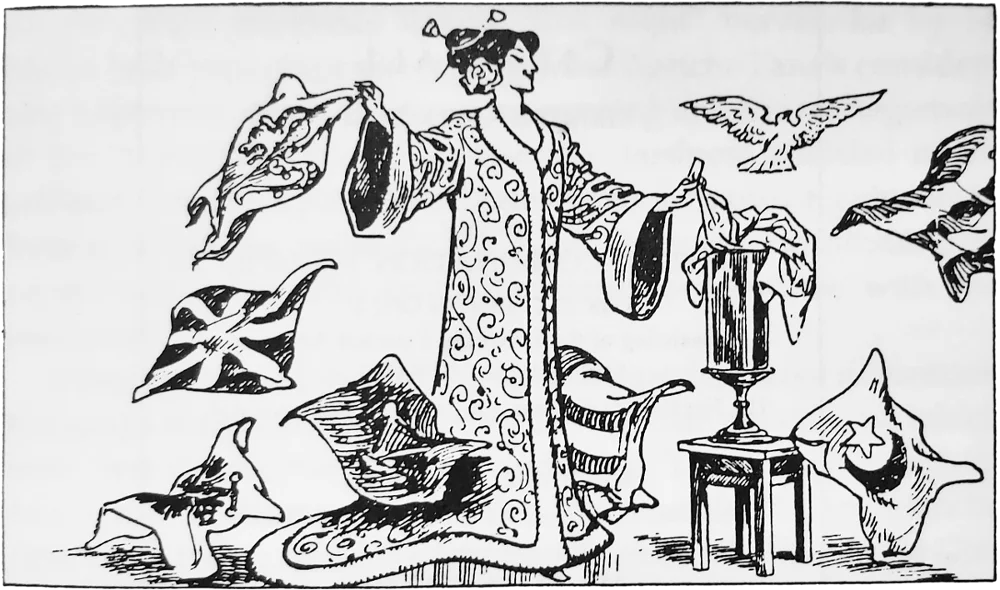
Illustration: Servais Le Roy's Magicial Monthly
Once infected by the show business virus it is very difficult to eradicate so with frustration at not being able to perform gymnastically Jane turned her hand to magic. Magic in the 19th century was exceedingly popular and there were no female practitioners in New Zealand. Jane became obsessed and devoted herself entirely to putting together a professional act. The first thing she worked on was a silent act as a Japanese maiden. In the meantime she had to support herself so took a job as a barmaid in Thames. The gold rush in New Zealand took place at Gabriel’s Gully near the Tuapeka river in Otago in 1861 but another minor rush took place on the Coromandel peninsular in 1867 and prospecting there lasted for a number of years. The population of Thames rivalled that of Auckland with 11,000 there in the early 1870s and more than 90 hotels. Because of the population density it was a popular place for touring shows to play and the perfect place for Jane to be with access to both work and entertainers. When Jane felt her act was ready she started performing her Japanese act in Thames.
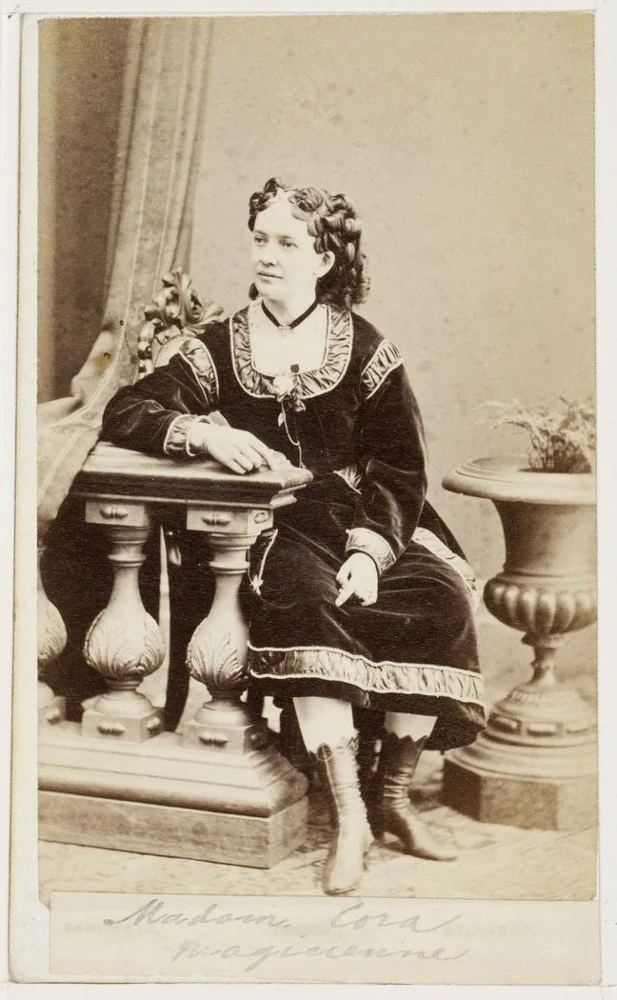
Cora De Lamond
Fortuitously two things happened in 1873. An American female magician toured New Zealand. This was Ursula Bush of Ohio who performed under the nom de theatre of Cora De Lamond. Cora did sell out business in Auckland where her season was extended and she received rave reviews. Cora then moved to Thames where she appeared at the Academy of Music from the 8th to 21st July. It was here that Jane observed Madame Cora’s show a number of times and resolved to put together an additional patter act.
At the beginning of December the Lynch family of bellringers arrived with supporting artists including Frank Verten, an Ethiopian comedian and dancer, and Harry Seymour; pianist and magician. Both these performers had European reputations. In show business terms of the era 'Ethiopian' indicates what today we would call ‘blackface’. On arrival the troupe found both Auckland theatres occupied and booked in advance so decided to go to Thames and return to Auckland later. In Thames they met and observed Jane’s act. It was obviously more than Jane’s stage ability that captured Frank Verten’s imagination. Leaving the bell ringer’s show, Frank Verten and Harry Seymour formed their own company the Oxford Combination Troupe incorporating Jane who now had two presentable acts. The Auckland Star of March 9 carries the following advertisement and it is interesting to note that Jane is still using her nom de theatre, Blanche Fane, and is topping the bill.
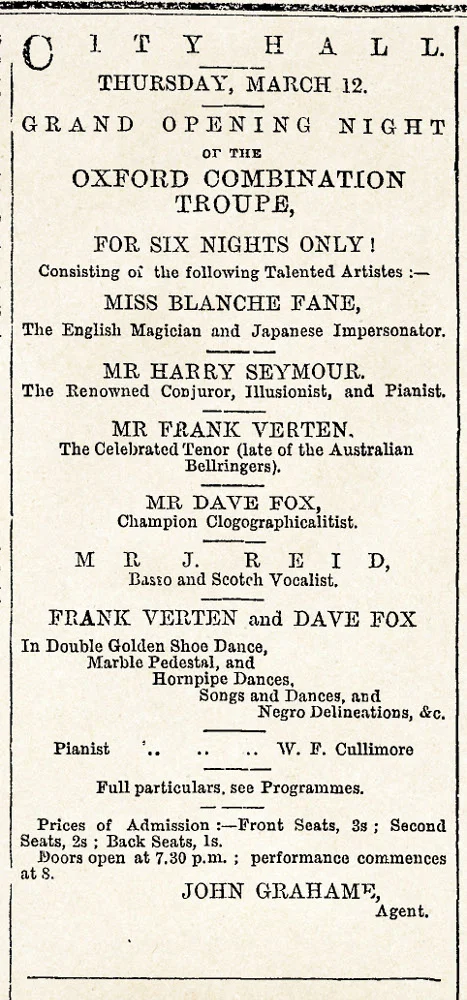
Auckland Star, Volume V, Issue 1275, 9 March 1874
Initial reviews of Jane/Blanche’s acts were insipid at best but with every following review they improved dramatically. The fact that two veteran and very experienced performers positioned her at the top of the bill shows they had faith in her ability. Jane was young, she was pretty, at this young age had years of experience in public and according to reviews had remarkable stage personality and charisma.
The Oxford Troupe very successfully played Auckland, Waikato, Thames, Coromandel and then headed north where again they achieved great success with multiple bookings at the Mangawhai Hotel. While in Auckland Jane and Frank Verten had married so for the northern tour the billing was now Madame Blanche. On September 11th 1874 the troupe boarded the ship Marmion at Te Kopuru bound for Wellington. The intention was to play Wellington but on arrival the only theatre was occupied by an opera company and all other halls were booked well in advance. Where to now? They knew that the magician Chapman was playing an extended season in Christchurch and didn’t want to go head to head so opted to go to Dunedin and work their way north.
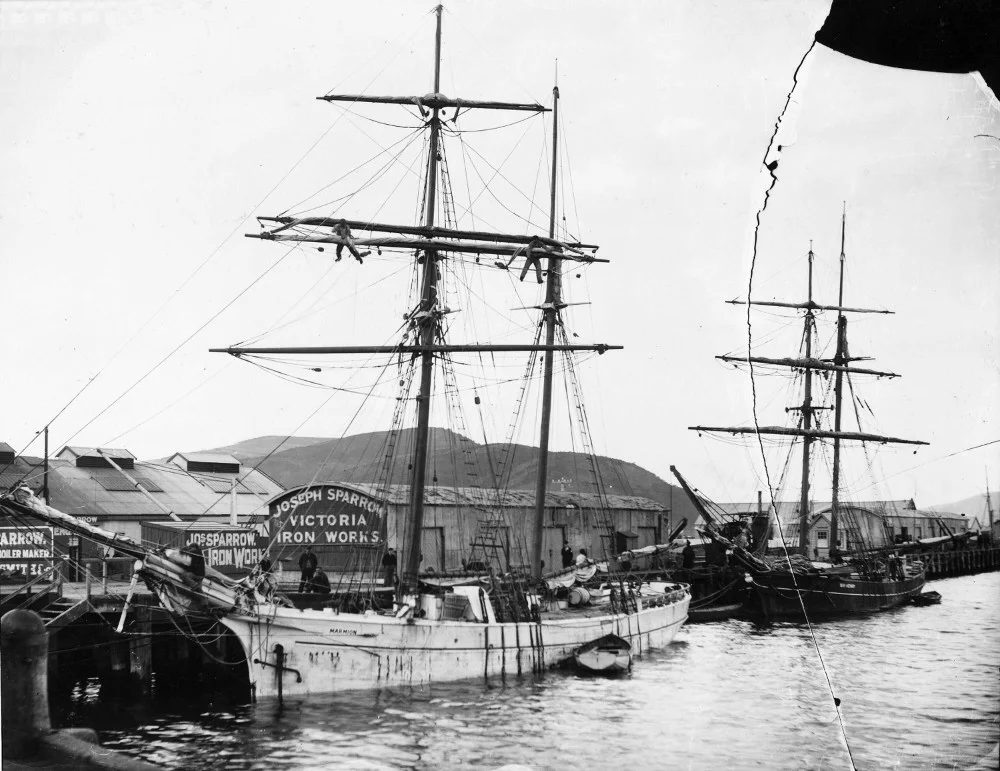
The ship Marmion, alongside Joseph Sparrow's ironworks, Dunedin. Ref: 1/1-002248-G. Alexander Turnbull Library, Wellington, New Zealand. /records/23204928
On 3rd October 1874 the show opened in the Masonic Hall to a packed house. Again Jane had a name change, now she was billed as Miss Blanche Anderson. Dunedin was settled by Scots and immigrants from Scotland made up the vast majority of inhabitants. The magician John Henry Anderson was a household name in Scotland as one of its biggest stars. By adopting the name Anderson, Verten and Seymour were trusting there would be an association and there was, as rumours went around that Blanche was John Henry’s daughter. Their season was so successful at the Masonic Hall that they moved the show to the Princess Theatre where they played an additional ten days to excellent business. From Dunedin the troupe headed into Otago and Southland in November, returning for another successful season in Dunedin for Christmas. As a result of the gold rush, Dunedin was the most populous city in the country in 1874 with a population of 18,500.
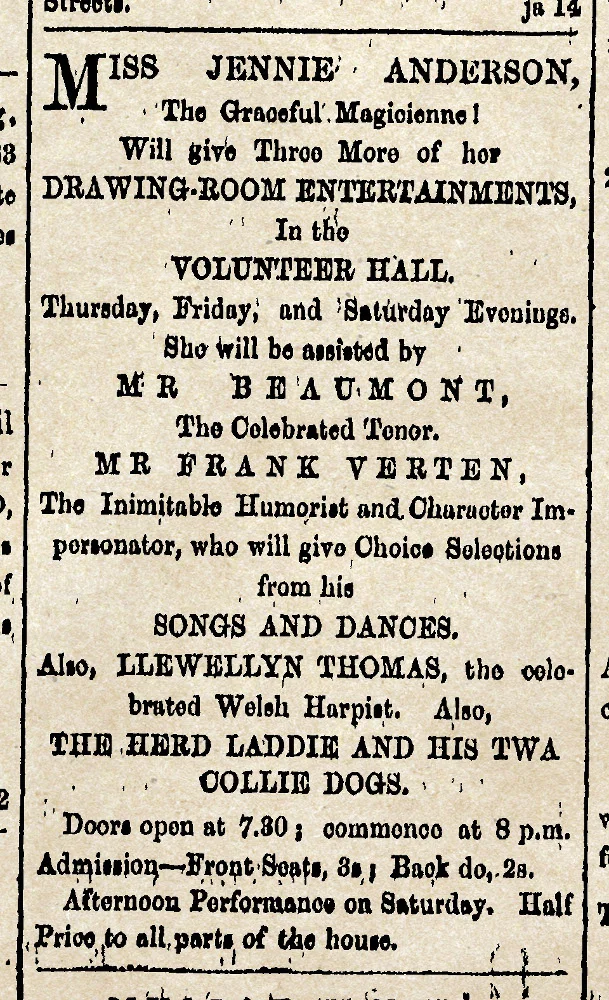
North Otago Times, Volume XXI, Issue 1017, 14 January 1875
The advertisement above is from the North Otago Times of 14th January 1875 and note it states 'three MORE of her......' This is advertising three additional shows extending the season in Oamaru. These three additional nights were Thursday, Friday and Saturday the 14th, 15th, 16th, January 1875 and were the last shows Jennie would ever perform.
Early on the morning of Sunday 17th January the troupe left for Waimate by their coach and arrived at the Waitaki river. Heavy rains meant the river was swollen and the bridge was under repair so the coach could not cross. They moved further down the river and located a pilot to guide them across. The pilot directed all but Jennie to walk across the under-repair bridge up river. The pilot assigned a driver to guide the coach across with Jennie inside to take care of the two collie dogs that were an integral part of the show.
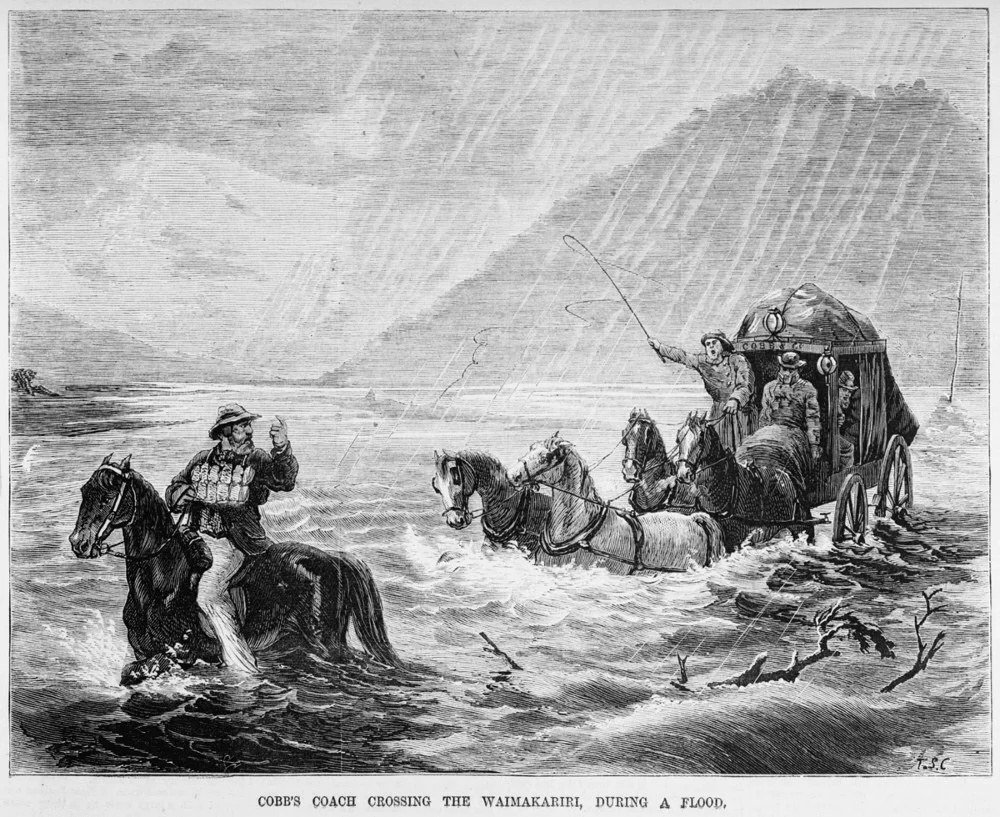
Cobb and Co's coach crossing the Waimakariri River in flood. Engraving made from a drawing by Thomas Samuel Cousins for "The Illustrated New Zealand Herald" of 1875
The pilot misjudged two things, the depth of the water and the speed of the underflow. When the coach reached mid stream the pressure of water against the coach swung it round so the horses lost control. The coach tipped over and Jennie was thrown violently against the frame losing consciousness. She was swept rapidly down river passing under the bridge. Frank Verten made a futile attempt to catch her. He managed to grasp some of her clothing which tore free as she was swept by the violence of the river much further down stream and drowned as did the horses and dogs. Shell shocked, the entire troupe, minus its star stood forlornly at the end of the bridge. They had lost everything, the star of the show, their means of transportation, all show properties, all personal possessions and the money box which was flush with funds from the highly successful tour.
The local people took pity on this shattered group of entertainers and one resident took it upon himself to raise funds to help this stranded troupe. The sum of eight pounds ten shillings was raised to assist them.
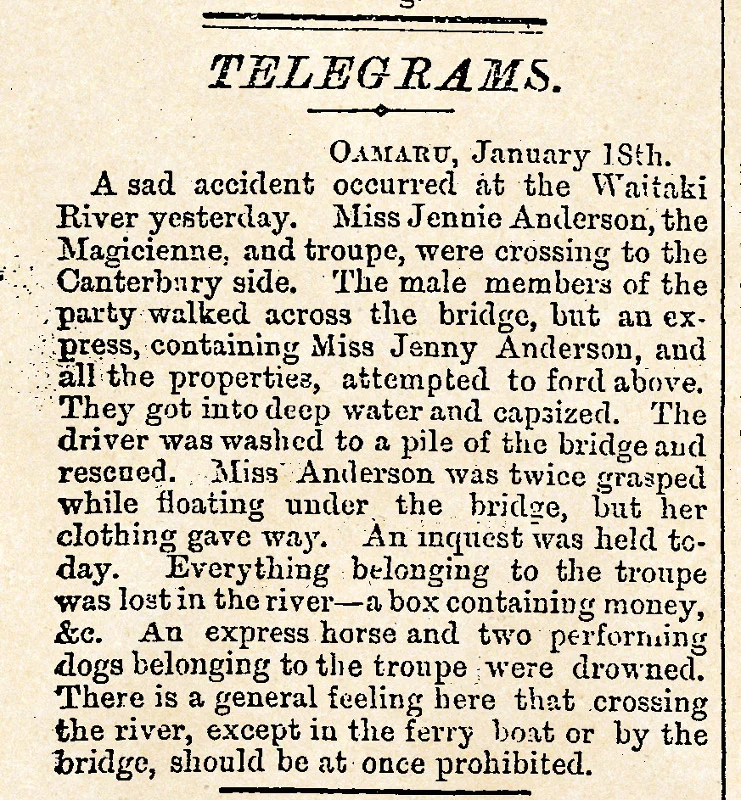
Otago Daily Times, Issue 4031, 19 January 1875
Jennie Anderson/Jane Whiteside/Jane Verten died just 16 days short of her 20th birthday and less than a year after her marriage. She was buried in Oamaru cemetery at 2:00pm on Tuesday 19th January 1875 with a small group of her devastated fellow troupe members saying farewell......
But fate was not finished with Jennie Anderson. As New Zealand’s first professional magician it seemed only correct that her grave should be located and the magicians of the country restore it, clean it and take care of it. The original burial records showed that she was buried in Bock 101, plot 7 and there was no headstone so we contacted the Oamaru Cemetery. The story they told was devastating.The area in which she was buried was on a steep embankment in the cemetery. In 1940 there were massive incessant rain storms in the area and the embankment came down in a huge landslide. All that was left was a jumbled mess of broken gravestones, disinterred coffins and debris in a heap at the bottom of the hill. The entire area was landscaped and planted in trees so today there are no markers nor any way of assessing where she was originally buried.
In my research of performers of the era I have been able to locate photos or illustrations of many performers of the 1870s and earlier – example, Madame Cora de Lamond above – but have never been able to locate a photo of Jennie. At that time all performers had what were called ‘cabinet photos’ which they used for publicity and to hand out. Jennie would definitely have had these as Madame Cora had photographs done in Thames. I contacted many Whitesides in New Zealand to see if they were descendants or members of that family and if any member had carried out any geneaological trees and could provide images or further information. I drew a blank. If any reader is in a second hand shop and there are historical photos or images around check them for any of the above names.
Darling Jennie by Chris Priestley
Bernard Reid GMM, professional magician for more than 50 years and now author has a passion for the evolution and history of magic. For many years he wrote for Magicana Magazine on the history of magic in New Zealand. He has written several books chronicling the history of magical entertainment in New Zealand dating back to 1855.
Do you have any new information on Jennie Anderson? If so please contact the I.B.M. in New Zealand on: info@magicians.org.nz

